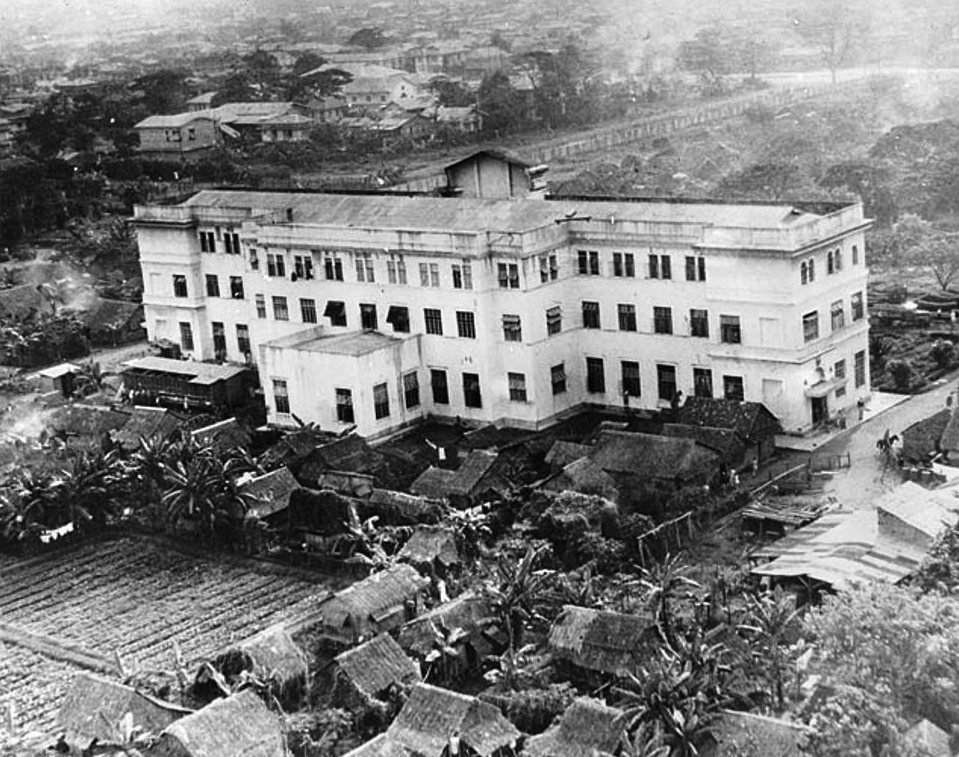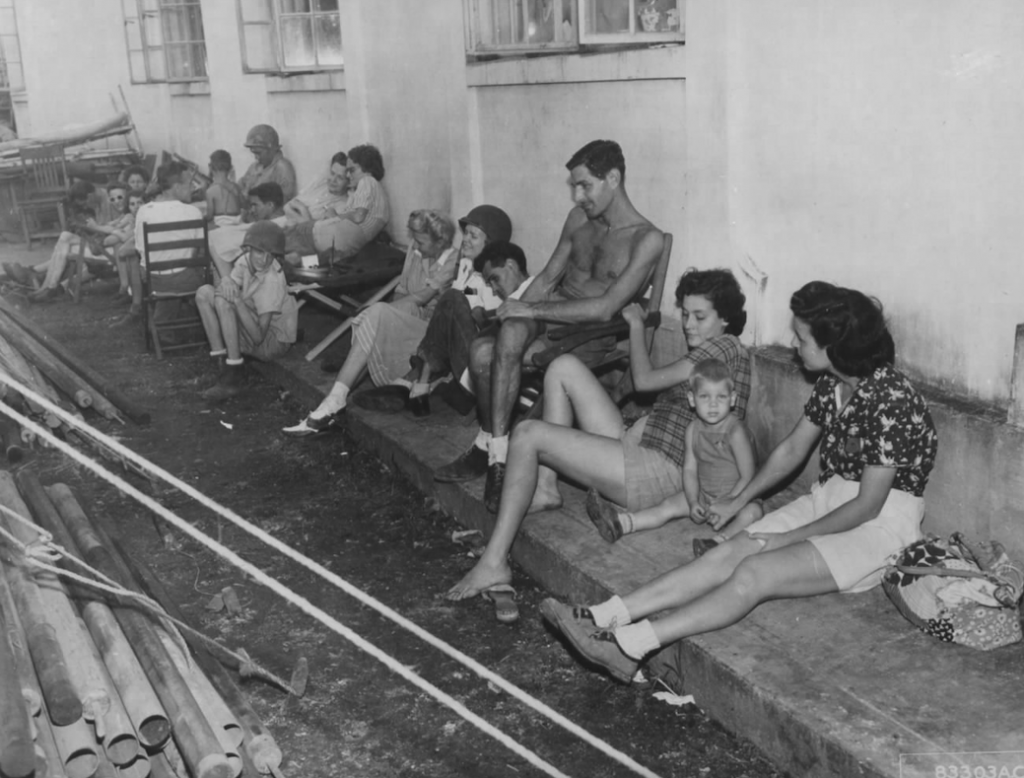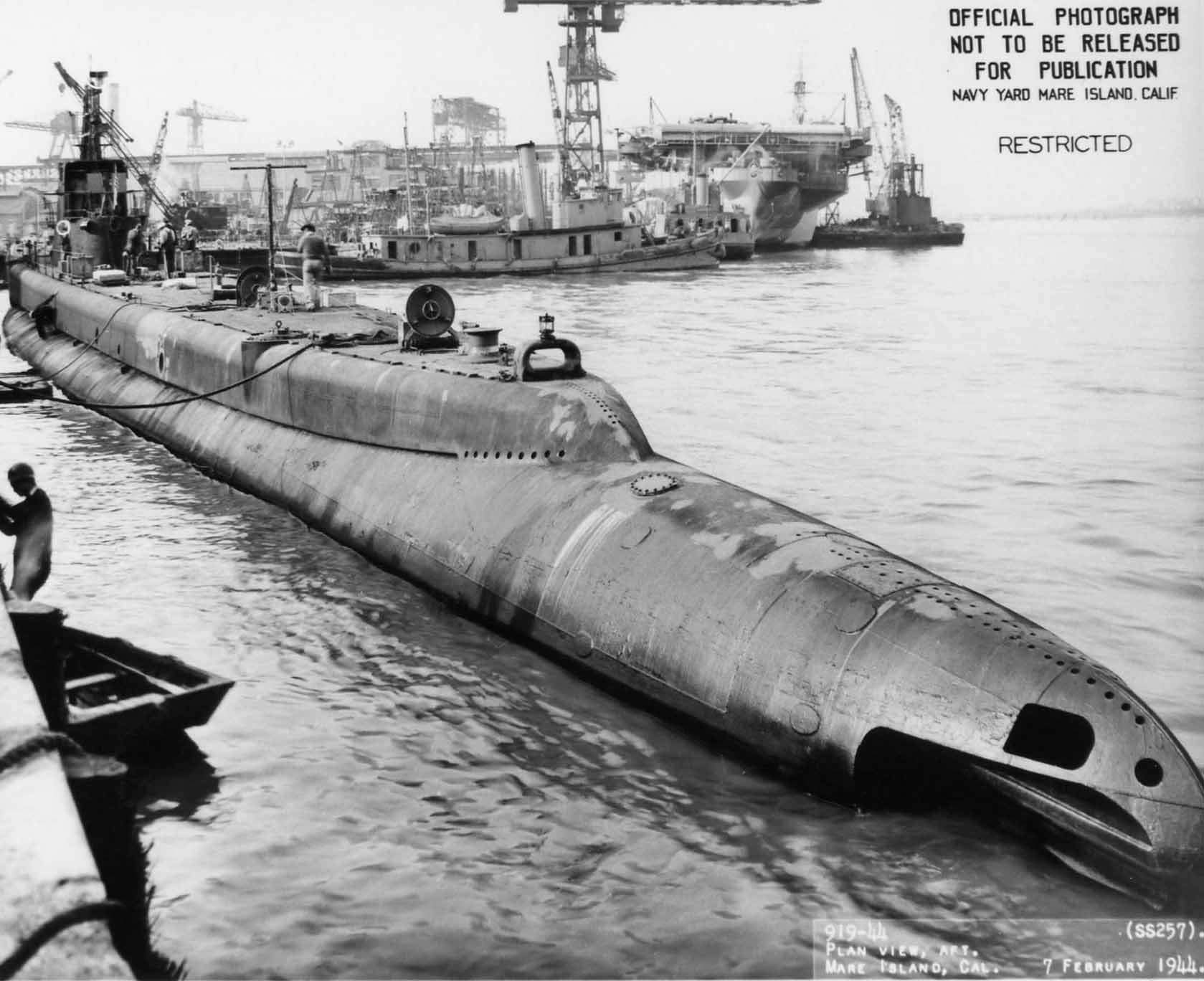On December 8, 1941, hours after the attack on Pearl Harbor, Japan launched an attack on the Philippines. In the following days, Japanese troops advanced rapidly towards Manila, the capital city. The US Army, under the direction of General Douglas MacArthur, decided to vacate Manila and move their forces, consisting of US soldiers and Filipino fighters, to the Bataan Peninsula. When the military left, thousands of American and British civilians, including men, women, and children, were left in the city. Many of them became POWs at Santo Tomas Internment Camp. Conditions at Santo Tomas were dire, but as Christmas 1942 neared, internees realized they could band together to create a holiday celebration for children at the camp. One of those prisoners was Associated Press correspondent Raymond P. Cronin. He recorded his experience and published it following his liberation.

With their military protectors gone and Japanese forces occupying Manila, Allied civilians (considered enemy aliens) were transported to the University of Santo Tomas. The university was a walled compound containing various buildings on roughly 50 acres. Prisoners arrived with meager possessions; some had only the clothes on their backs. Internees worked together to establish living quarters, plant gardens to provide food, establish medical facilities, and construct additional latrines.
In late September, the prisoners from diverse backgrounds with various skills gathered to discuss the upcoming holiday season. They decided to organize their own Santa’s workshop. They were determined to provide Christmas gifts for every child in the camp. They built new toys out of wood scraps and painted them bright colors. They repaired old and broken toys donated to the camp by Filipino friends. With meager materials, prisoners carved, crafted, and created the gifts. Soon, internees had built cars, scooters, and rag dolls, complete with doll wardrobes. Shortly before Christmas, internees learned that a group of children had just arrived from the Iloilo Internment Camp. There were no gifts for the new arrivals, so the internees worked feverishly to construct 100 more presents.
Christmas morning arrived, and Santa came to the guard gate at Santo Tomas. For a moment, Japanese soldiers seemed to get in the spirit of things and let Santa in without a pass. Internees gathered around a giant Christmas tree brought in from the Baguio Mountains. There, Santa distributed hundreds of gifts. Every child in the camp received presents and words of cheer. Compassionate friends on the outside donated roasted turkeys, pigs, ice cream, cakes, and candy.
For 3,500 internees at Santo Tomas Internment Camp, the Christmas of 1942 was never to be forgotten. Except for a few prisoners released on exchange, those interred at Santo Tomas spent three years as POWs. They were liberated in February 1945.
If you would like to learn more about the Fall of the Philippines and the Battle of Manila during WWII, search Fold3® today.







May the American Defenders of Bataan and Corregidor Memorial Society repost your story on our website page?
Yes, Debbie. Thank you for asking.
However some of the women, who were teachers, were repeatedly raped by the Japanese soldiers. One if them was my wife’s high school teacher in Denver after the war.
There is no mitigation for such whether in peace or war , death is the right out come for perpetuators of such violence
A very emotionally laden story. Thank you for posting. One of my seven brothers who fought in WWII, was part of the US Army that liberated Manilla and the Philippines.
My father was there too.
My grandfather was an engineer, captured, and detained at Los Banos. I believe he was first in Santo Tomas.
Shortly before the war ended, he was killed, outside of the fence, returning with food for the prisoners. He had been warned to stop escaping.
His name was John Howard (Pat) Hell.
Ann Hell Lloyd, God bless your grandfather for giving his greatest gift for the survival of the other prisoners.
What an inspiring story of courage and industry based on a sense of creating a home away from home. This filled my heart up with a compassion for those who lived through war times and in dire conditions. God Bless them and their ancestors who followed. Many of them could still be living today. Merry Christmas
For sure!!
I would like to use this article in my family and our Genealogy Newsletter, many of which were in the military. Thank you. Terri Lanini, President of Sweet Home Genealogy Society. Sweet Home, Oregon
Imperial Japan soldiers, as reported by a friend of my Mother’s who lived through the Japanese occupation of the Philippines, were brutal and sadistic occupiers. They were as evil as what we see and read coming out of Israel and Gaza today at the hands of Hamas.
My grandfathers brother, Charles H Davies, his Spanish wife Conchita Rocha, and their young (15) son Charles A Davies. Spent the war in the Santo Tomás prison camp Charles worked for the Spanish Philippine Tobacco Co. A short time after they were liberated they went back to England and finally settled in Spain.
My grandfather said that they had a very rough time. Sometime back I discovered a website created by several ex internees. Very, very interesting: http://www.cnac.org/emilscott/santotomas01.htm
I just read these stories. How very interesting and emotional! When will the world of humans be able to love each other, understand differences, and to stop these terrible wars.
To think the descents of this terrible times have to be targeted because they are Japanese . There is no answer. Children don’t hate each other…. We as adults teach them. So sad!
My Uncle Morris was among the injured . My family
never really knew what happened to him. He was listed so many different ways .Morris and Maurice . Penan or Pinion .
My father was a soldier who served during WWII and was involved in the liberation of Manila. He rarely spoke of his time in the service, of the horrors of war, but I do know he was deeply affected by what he witnessed. I appreciate reading stories such as this one, as it was never really passed along.
Why didn’t the US evacuate the Americans in Manila when MacArthur withdrew his troops
Well said sir.
Let’s keep our comments from becoming divisive, mean, and political. The purpose of this article is to focus on the collective good of POWs who tried to bring joy to imprisoned children during the holidays.
Thank you, Wes and Maurice, for sharing sharing Jenny Ashcraft’s account (November 23, 2023)
of AP Raymond Cronin’s experience of our first Christmas (1942) in Santo Tomas internment
camp during WWII. I was too young (at three and a half years old) to recall that first Christmas,
however, I still have a painting my father did of my younger brother, Philip/Felipe and I, outside
our ‘shanty’, pushing a wooden wheelbarrow and riding a wooden tricycle. This painting now has
so much more meaning following the reading of this wonderful account! I will, today, post a
copy of this story to the back of my father’s framed painting, as a reminder of this ‘never-to-be-
forgotten’ day, those many years ago!
Peace and love to all.
Thank you so much for sharing!
Thank you to so many who sacrificed for us that we don’t know all they did. We owe so much.
Thank you for sharing
My uncle a Sgt in the Army and a marine swam from Bataan to Corregidor to prevent capture, only to be captured by the Japanese, enslaved, and spent the rest of the war in a prison camp 20 miles from Hiroshima Japan.
My Uncle, a Sgt in the Army ands Marine swam to Corregidor to avoid capture, only to be captured by the Japanese; enslaved, shipped to the mainland some 20 miles from Hiroshima until they were liberated.
My uncle, a SGT in the US Army and a US Marine swam from Bataan to Corregidor to avoid capture, only to be enslaved by Japanese, shipped on the Hell Ship to a Camp 20 miles from Hirashima until he was liberated.
My mother and her entire family (mother, father, sister, 2 brothers, and grandmother and her 2 adopted boys) were interned at Santo Tomas. She was only a teenager when interned. She took care of her parents in the hospital there due to bouts of malaria. She also took care of her brother in the hospital due to a kitchen accident. She often helped take care of the boys because they were young. Everyone did what they could to make life there more bearable. Friends on the outside did throw food over the fence until the Japanese soldiers started to shoot them. She had friends that died in camp. This entire experience took a toll on my mother both physically and mentally for many years and especially in her later years.
It’s hard to imagine what she must have experienced. Thanks for sharing!
I had turned 8 years old only three months before Pearl Harbor. We lived in Santa Monica, California only a few blocks from the Douglas Aircraft factory. I was too young then to understand the significance of what happened. The following spring, when class was out for recess, I saw airplanes, probably biplanes, dog fighting approximately over the Douglas air field. I was so fascinated that another kid had to pretty much drag me back into class. Also, it didn’t take long for a lot of barrage balloon installations to be put in place and the aricraft plant to become hidden by camouflage.
A couple of years later, after we had moved to Burbank, once in a while I could take the streetcar into Glendale where they had more movie theaters than Burbank. Out toward the front of the Cosmos the box office had been reconfigured to look like Tojo. One was supposed to kick him in the teeth when buying a ticket. At about ten years old, that certainly seemed like something we should do. It was probably about the same time that Spike Jones came out with Der Furer’s Face. I had to have that ten-inch 78 rpm record and played it to death.
My husband,parents and sister were in Japan.some caught the last boat to Australia though they were later returned. My father in law was taken the Haiphong Road camp. Afterwards he was taken to Fengtai camp and released on 25 August 1945.
Thank you for your personal accounts. I am the daughter of a 2nd Lt. Army Nurse who was stationed at Ft. Stautsenburg near Manila in 1937. Mom worked in US Base hospital nursery when General Arthur MacArthur’s son was born. She married my Dad in 1939 and built a home near Baguio. In 1931 (due to US Depression) Dad arrived in the Philippines for work in the logging industry. My parents thank the Filipino people for warning them of the impending Japanese invasion and the potential they would be taken as prisoners by the Japanese. The jungles around Baguio were receiving provisions for an invasion. August 1941 Mom waited for two weeks on the docks in Manila to get a ship passage to the US. Dad worked his way to the US on a Navy ship as a dishwasher. Women and children evacuating to the US were given passage priority. I was born 9 months after my parents arrived in the US. The home Mom and Dad built in Baguio was used for housing Japanese military officers. Army Nurse, Juanita Redman replaced Mom at the US Base hospital and wrote a book “I served on Bataan”. Fleeing as refugees Mom and Dad lost all finances associated with their home and logging company
earnings. Mom’s 16 millimeter camera reels of film remain telling the story of life in Manila and Baguio in 1939 before the Japanese invasion. Many thanks to the Filipino people my Mom and Dad left the P.I. before war began. Mom’s bridesmaid, an Army Nurse, was taken as prisoner and later gave birth in a Concentration Camp to a son who became afflicted with polio.
My father Captain Beverly R Gibbon was on one of the gun installations on Corregidor when he was captured. He spent over three years in Japanese prison camps ending in Cabanatwan when liberated.
Jenny, I am writing a book about my father-in-law’s days as an MIA in the Philippines in November 1944. Several of the men who saw to his safety and lead to his evacuation worked at the Old or New Bilibid prison. I wrote a couple of paragraphs about the Bilibid prisons and would like to include some information about Santo Thomas and perhaps the photo of the hospital/prison. If you would give me your permission and cite information I would be most grateful.
My mother and her entire family ( father Col William E. Dosser Army, wife and sisters) were placed in Santo Tomas and later sent to Bilibid Prison. She refused to talk about her time there when I was younger. Later in life she spoke briefly and then she got Alzheimers Disease and the only thing she talked about was her home in the Philippines. Sad that that is all she remembered.
If you like old-time radio programs, you might be interested in listening to “Forbidden Diary: True WWII Prison Survival Story” based on the diary written by Natalie Crouter when she was interned from 1941-1945 in a Japanese prison camp in Baguio. The reason her diary is considered important is that she wrote daily, including Christmas. Her experience was different than Santo Tomas because Baguio is up on the mountains and the civilian internee population smaller. Season Two (1942) includes interviews with the archivist at the MacArthur Memorial library.
To find it Google the title or go to the website.
Here’s the website http://www.storiestovoice.com/fd-listen